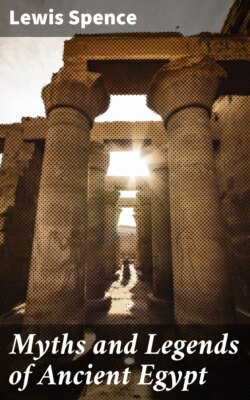Читать книгу Myths and Legends of Ancient Egypt - Lewis Spence - Страница 42
На сайте Литреса книга снята с продажи.
The Egyptian Temple
ОглавлениеThe earliest form of temple was a mere hut of plaited wickerwork, serving as a shrine for the symbols of the god; the altar but a mat of reeds. The earliest temples evolve from a wall built round the name-stelæ, which was afterward roofed in. With the advent of the New Empire the temple-building became of a much more complicated character, though the essential plan from the earliest period to the latest remained practically unchanged. The simplest form was a surrounding wall, the pylon or entrance gateway with flanking towers, before which were generally placed two colossal statues of the king and two obelisks, then the innermost sanctuary, the naos, which held the divine symbols. This was elaborated by various additions, such as three pylons, divided by three avenues of sphinxes, then columned courts, and a hypostyle or columnar hall. In this way many of the Egyptian kings enlarged the buildings of their predecessors.
These temples stood in the midst of populous cities, the huge surrounding wall shutting out the noise and bustle of the narrow streets. Leading up to the great pylon, the chief gateway, was a broad road carried right through the inhabited quarter and guarded on each side by rows of lions, rams, or other sacred animals. In front of the gateway were two obelisks, likewise statues of the king who founded the temple, as protector of the sanctuary. On either side of the entrance stood a high tower, square in shape, with the sides sloping inward. These were of course originally designed for defensive purposes, and the passage through the pylon could thus be successfully barred against all foes, while from postern-gates in the wall sorties could be made. Tall masts were fixed in sockets at the foot of the pylon. From these gaily coloured streamers waved to keep afar all menace of evil, as did the symbol of the sun, the Winged Disk, over the great doors. These were often made of wood, a valuable material in Egypt, and covered with a sheathing of glittering gold. The outer walls were decorated with brightly coloured reliefs and inscriptions, depicting the deeds of the founder, for the temple was as much a personal monument as a shrine of the tutelary deity. Inside the pylon was a great court, open to the sky, usually only colonnaded on either side, but in larger temples, as that of Karnak, a series of columns ran the length of the centre. Here the great festivals were held, in which a large number of citizens had the right to take part. By a low doorway from this the hypostyle was entered, the windows of which were near the roof, so that the light was dim, while the sanctuary was in complete and profound darkness.
